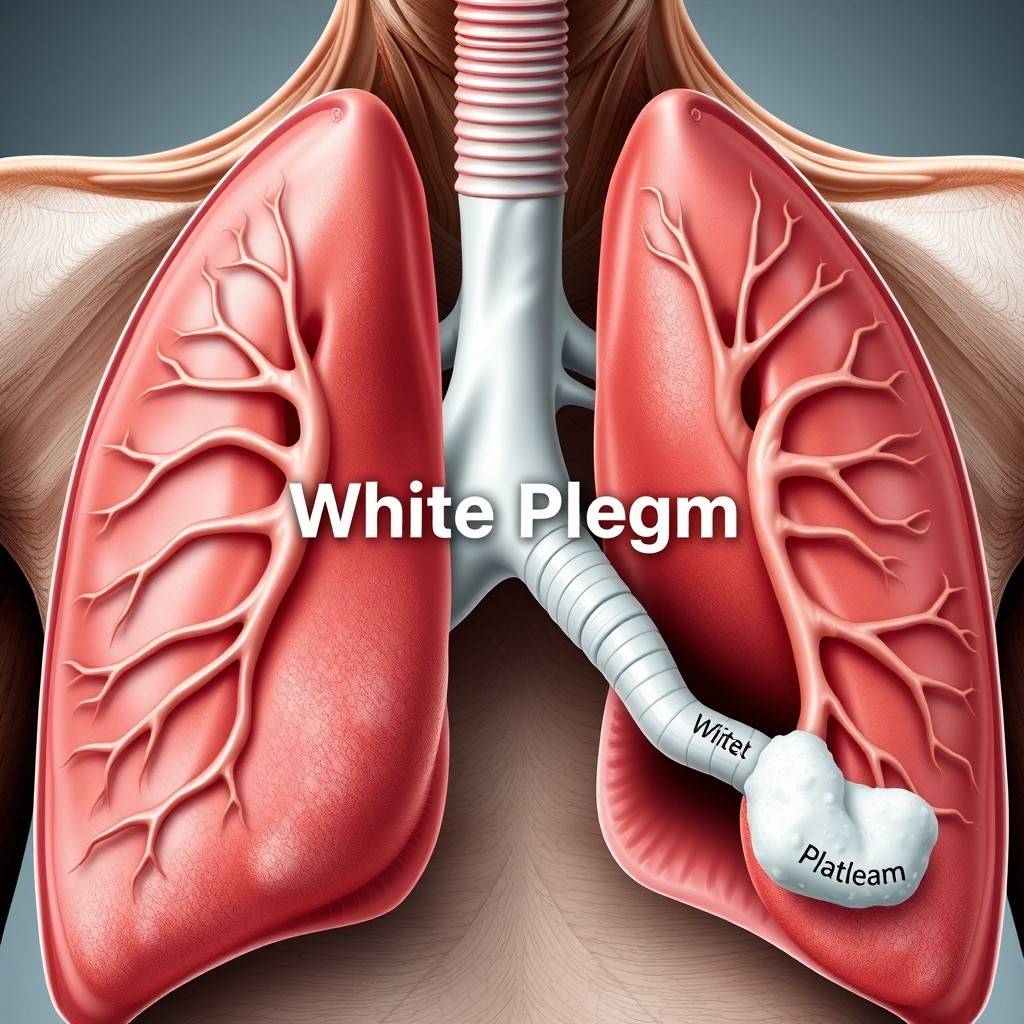Wondering why you’re coughing up white phlegm? Discover causes, symptoms, and effective treatments. Learn how to find relief now! White phlegm can be a concern. This mucus helps remove harmful particles. When it’s white, it may indicate health issues. This article will cover symptoms, causes, and treatments for white mucus in simple terms.
Understanding White Phlegm
What is Phlegm?
The respiratory system produces phlegm, a specific kind of mucus. It’s a thick, sticky substance that helps trap dust, bacteria, viruses, and other harmful particles, preventing them from entering your lungs. Normally, phlegm is clear or slightly cloudy, but when you’re sick, it can change in color and consistency.
What Does White Phlegm Mean?

It typically indicates a mild infection or irritation in the respiratory system. It’s often associated with colds, allergies, or sinus infections. While White sputum might seem concerning, it’s usually not something to worry about unless it is accompanied by other serious symptoms. However, it’s important to pay attention to the type of phlegm and any additional symptoms that I think will arise.
Causes of White Phlegm
There are several reasons why you might produce white sputum. We’ll examine the most frequent causes
1. Common Cold
The common cold is one of the leading causes of white phlegm. When your body fights off a viral infection, your immune system produces more mucus. In the early stages of the cold, the mucus is typically clear or white. As the cold progresses, it may turn yellow or green because of the increase in white blood cells fighting the infection.
2. Allergies
Allergic reactions to pollen, dust, pet dander, or mold can cause the production of excess mucus. If your allergies are flaring up, you might notice White sputum. It often comes with sneezing, a runny nose, and itchy eyes. Phlegm can appear thin and clear, or it might be white.
3. Sinus Infection (Sinusitis)
Sinusitis occurs when the lining of your sinuses becomes inflamed because of infection or irritation. This inflammation leads to increased mucus production, which can result in white or cloudy phlegm. Along with the phlegm, you may experience facial pressure, headaches, and congestion.
4. Post-Nasal Drip
Post-nasal drip happens when mucus from the sinuses drips down the back of your throat. This is common during colds, flu, or allergy flare-ups. The mucus may be white and cause coughing, throat clearing, and discomfort.
5. Bronchitis
Bronchitis, which is the inflammation of the airways, can cause the production of white phlegm. Acute bronchitis is usually triggered by a viral infection, while chronic bronchitis is linked to smoking and long-term exposure to irritants. In either case, your body produces extra mucus, and the phlegm may be white, especially in the early stages of the illness.
6. Dry Air or Irritation
Sometimes, the environment can play a role in the production of phlegm. Dry air, especially in winter months, can irritate the airways, causing them to produce more mucus. This mucus can be white and thick, especially when you’re dehydrated.
Signs and Symptoms to Watch For
While white phlegm itself is usually not a sign of something severe, it’s important to monitor any other symptoms you may have. Here are some signs that could indicate a more serious issue:
- Persistent cough lasts more than a week
- Shortness of breath or chest pain
- Fever above 100.4°F (38°C)
- Fatigue or weakness
- Blood in phlegm
- Wheezing or difficulty breathing
If you experience any of these symptoms along with white mucus, it’s important to seek medical attention.
Treatment for White Phlegm
Most cases of White mucus resolve on their own with simple self-care. Here are some steps you can take to relieve symptoms and speed up recovery:
1. Stay Hydrated
“Consuming ample fluids thins the mucus, facilitating easier expulsion. Warm fluids like tea, soup, and broth can also soothe your throat and reduce irritation.
2. Use a Humidifier
Dry air can make your symptoms worse, so using a humidifier to add moisture to the air can help ease congestion and prevent the phlegm from becoming thicker.
3. Rest
Your body needs time to heal. Ensure you’re getting enough rest to help your immune system fight off the infection causing the phlegm.
4. Over-the-Counter Medications
Over-the-counter medications like decongestants, expectorants, or antihistamines can help reduce mucus production or make it easier to expel phlegm. However, consult with a healthcare professional before using these medications, especially if you’re pregnant or have any preexisting conditions.
5. Saltwater Gargle
Gargling with warm salt water can soothe an irritated throat and help loosen mucus. It’s an easy and effective way to manage discomfort caused by white fluid.
6. Steam Inhalation
Inhaling steam can help loosen phlegm and clear up congestion. You can do this by taking a hot shower or breathing in steam from a bowl of hot water (cover your head and the bowl with a towel to trap the steam).
7. Avoid Smoking and Irritants
Smoking and exposure to irritants like dust or strong chemicals can worsen your symptoms. Avoid these triggers while you’re recovering.
When to see a doctor
Most cases of white phlegm can be managed at home, but you should see a doctor if:
- Your symptoms persist for over 10 days without showing signs of improvement.
- You have a fever, chest pain, or difficulty breathing.
You are coughing up blood or notice a significant change in the colour of the phlegm.
- You have underlying conditions such as asthma, COPD, or heart disease that may make respiratory issues more serious.
White Phlegm in Children
If your child is coughing up white sputum, it’s often a sign of a mild viral infection or allergies. However, if phlegm persists, or if your child has difficulty breathing a fever, or any other concerning symptoms, it’s best to consult with a pediatrician. For children’s health, always prioritize caution.
White Phlegm During Pregnancy
Pregnant women can also experience white phlegm, especially during a cold or because of hormonal changes that affect mucus production. The same treatments that help with white sputum, such as staying hydrated and using a humidifier, are safe during pregnancy. However, always check with your doctor before using any medication, even if it’s over the counter.
Clear Mucus vs. White Phlegm
You may have noticed that phlegm can be clear, white, yellow, or even green. So, what’s the difference?
- Clear mucus is often normal and indicates no infection. It’s usually produced when you’re healthy or have minor irritation like dryness in the airways.
- White phlegm often indicates mild infection or congestion, usually from a cold, allergies, or sinus irritation. It is thicker than clear mucus, which makes it easier to notice when you cough or clear your throat.
While both clear and white mucus is typically benign, pay attention to the colour change in your phlegm. Yellow or green phlegm often signals a bacterial infection, which may require medical treatment.
White Phlegm and Respiratory Issues
If you have conditions like asthma, chronic bronchitis, or COPD (chronic obstructive pulmonary disease), you may notice persistent white sputum. These conditions cause inflammation and irritation in the airways, which leads to increased mucus production. In chronic cases, white mucus may become thicker or even yellow.
Chronic White Phlegm
Chronic white phlegm can also be a sign of chronic bronchitis, which is common among smokers or those who are exposed to irritants. This condition is part of COPD and often involves long-term coughing with sputum (phlegm).
If you’re dealing with chronic White mucus, it’s important to discuss your symptoms with a healthcare provider who can offer solutions to manage your condition and help prevent further complications.
Natural Ways to Reduce White Phlegm
Several natural remedies can help reduce the amount of white phlegm in your body. These remedies help by soothing irritation, thinning the mucus, and promoting easier expulsion of phlegm.
- Honey and Ginger Tea: Honey has antibacterial properties, and ginger helps reduce inflammation. This combination can soothe your throat and help clear excess mucus.
- Peppermint Tea: Peppermint has menthol, which can help break down mucus and provide relief from congestion.
- Steam Therapy: As mentioned earlier, inhaling steam can help loosen white phlegm and make it easier to clear from the airways.
- Garlic: Renowned for its natural antibacterial and antiviral qualities. It can help boost your immune system and reduce inflammation in the respiratory system.
White Phlegm and Other Health Conditions
Sometimes, White mucus is a sign of a more serious underlying condition, especially if it’s accompanied by other symptoms. Some conditions to consider include:
Sinus Congestion and Sinusitis
If you have sinus congestion, the sinuses can become inflamed and produce white or cloudy mucus. This often causes headaches, facial pressure, and congestion.
Respiratory Infections
Viral infections like the flu, common cold, and COVID-19 can lead to the production of white phlegm. In some cases, the infection can progress and turn the phlegm yellow or green, signalling a bacterial infection that may require antibiotics.
Acid Reflux (GERD) and White Phlegm
Gastroesophageal reflux disease (GERD) occurs when stomach acid backs up into the esophagus, which can irritate the throat and lead to the production of white mucus. If you have GERD, managing the condition with lifestyle changes and medications may help reduce mucus production.
Mucus Color Meaning
Understanding the color of phlegm can provide valuable insight into your health. Here’s a quick guide to mucus color:
- Clear mucus: normal or mild irritation.
- White phlegm: Often a sign of a mild infection, such as a cold or sinusitis.
- Yellow or green phlegm: Indicates an infection, often bacterial.
- Brown or rust-coloured phlegm: This could indicate old blood or chronic bronchitis.
- Red or pink phlegm: This could indicate fresh blood, which requires medical attention.
Frequently Asked Questions
What does white phlegm indicate?
It usually indicates a mild respiratory infection or irritation, such as a cold, sinusitis, or allergies. It can also be caused by environmental factors like dry air or irritants. White mucus is typically not a cause for alarm, but persistent symptoms should be checked by a doctor.
Should I take antibiotics if I’m coughing up white mucus?
In most cases, antibiotics are not necessary for coughing up white phlegm, since they are often caused by viral infections that cannot be treated with antibiotics. Antibiotics are only effective against bacterial infections, so they are typically not prescribed unless a bacterial infection is diagnosed.
How do you fix white phlegm?
To fix White mucus, it’s important to manage the underlying cause. Staying hydrated, using a humidifier, getting plenty of rest, and using over-the-counter expectorants can help. Gargling with salt water and inhaling steam are also helpful remedies.
Does white phlegm mean heart failure?
It, on its own, rarely points to heart failure. However, if white phlegm is accompanied by shortness of breath, swelling in the legs, or fatigue, it could be a sign of heart failure or another serious condition. Always seek medical advice if you experience these symptoms.
Conclusion: Treating and Managing White Phlegm
White phlegm is often the result of a viral infection, allergies, or sinus congestion, and it usually clears up on its own with some self-care. However, if your symptoms persist or worsen, it’s essential to consult with a healthcare professional. In most cases, staying hydrated, resting, and using a humidifier can help manage symptoms.
If you’re coughing up White mucus, especially for an extended period, be sure to watch for additional symptoms like fever, chest pain, or difficulty breathing. If you experience any of these, seek medical attention right away.
Remember, paying attention to the colour and consistency of your phlegm is one way to monitor your health and catch potential issues early. Keep an eye on your symptoms and follow the remedies outlined above to keep your respiratory system in good shape.
Recommended Reading
Phlegm Stuck in Throat for Months 101? Causes and How to Fix It



